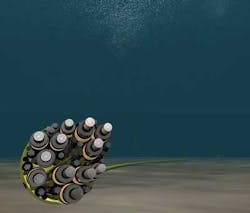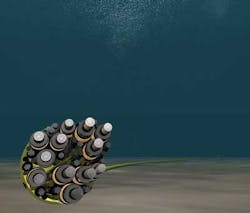Aluminum cable conductor eases water depth restrictions on power umbilicals
David Fogg
Alan Dobson
Alan Deighton
Technip
An umbilical is an assembly of fluid conduits, electrical and fiber optic cables, either on their own or in combinations, cabled together for flexibility. In any offshore field development the umbilical is a critical component for the production of hydrocarbons, providing electrical and hydraulic power, chemical injection, and telemetry to the subsea system.
The functionality of medium-voltage (6-36 kV) power cables for subsea production systems is becoming more attractive as confidence in subsea pumping and processing grows based on service experience. As operators strive to recover hydrocarbons from marginal developments, and more challenging and hostile regions, the design and reliability of the power link between the subsea system and host facility is increasingly important.
The term "static umbilical" refers to a product which connects two items of subsea equipment and which is designed to remain on the seabed throughout its design life. In this case the greatest challenge is typically installation. For all methods of deployment, maximum tensions are proportional to water depth, and strength requirements become design drivers during deepwater installation. Detailed analysis of the umbilical's response to complex loading helps address these design issues.
A "dynamic umbilical" refers to a riser section which connects an item of subsea equipment to a floating structure. In this mode, the umbilical must sustain the loads imposed by its own weight, the motions of the connected vessel, and the hydrodynamic effects of waves and currents, throughout the entire life of the field. All the umbilical components must be correctly designed with respect to both static and fatigue strength, therefore a full understanding of the load distribution mechanisms within the structure is paramount.
Conventional design
Inclusion of the medium-voltage power cores within the umbilical structure adds to the mass of the umbilical without significantly increasing the structure's strength, owing to the relatively poor mechanical strength of copper cables. Umbilicals containing a number of medium-voltage power cores pose a significant design challenge which can be compounded when the service of the umbilical is in "extreme conditions," typically highly dynamic service or installation and operation in deepwater in the Gulf of Mexico, Brazil, and West Africa.
The Integrated Power Umbilical (IPU) includes 12 x 150-sq mm medium-voltage power cores rated to 18/30kV with plain annealed copper cores (4 off 3-phase circuit). The power circuits are cabled together with high chrome alloy tubes, low-voltage signal cables, and fiber optic cables. Structural tensile strength is achieved through the support provided by the steel tubes.
A conventional static power cable consists of three 120-sq mm medium-voltage, plain annealed, copper power cores helically cabled together with a single fiber optic. Structural strength is provided by the two layers of counter-helically laid steel armor layers. In both instances the design, components and materials contained within the structures represent current technology with greater than 10 years of field-proven service.
To ensure that the umbilical has an adequate service life, the umbilical materials must be maintained in a stress state below allowable levels. Design of a conventional three-phase copper power cable with helical armor can be optimized for use in reasonable water depths.
However, an umbilical cross-section may incorporate a significant proportion of electrical conductor where more than one three-phase circuit is required. The conductor material in a design based on conventional copper cable conductors with steel armor reinforcement will, at a certain water depth, reach the limiting stress for safe operation. This could be way short of targets for future deepwater developments.
The IPU design has been assessed against three service conditions, each with an associated dynamic amplification factor applied to the axial load applied to the umbilical:
- Static or installation, with an associated dynamic amplification factor (DAF) of 1.1
- Quasi-dynamic, suspended from a spar platform or a TLP, with a dynamic amplification factor of 1.3
- Dynamic, suspended from a FPSO, with a dynamic amplification factor of 1.5.
Conventional conductors
Recent advances in umbilical strength member technology have extended the capability of copper cable power umbilicals. The inclusion of a strength member in the umbilical bundle increases the stiffness of the structure, reducing the strain on the other functional components. However, as the inclusion of extra components can also add to the suspended weight of the umbilical, the most important consideration is the ratio of stiffness to density of the strength member.
As the most effective strength member solution employed in an IPU can still fall short of ultra deepwater targets, a much lower risk arrangement would clearly be attractive. The optimum approach is to use a high-strength cable capable of sustaining the weight of the umbilical system and any additional material needed for ballast without the added complication of strength members.
As mentioned earlier, the copper conductor is the limiting component for highly loaded power umbilicals. An alternative to simply reinforcing the umbilical is to select a cable conductor capable of fulfilling the required electrical functionality with improved mechanical characteristics. A wide range of materials and conductor designs were considered, including copper alloys and designs with a variety of integral strain relief elements. Incorporating the grade Aluminum 6000 series into a medium-voltage power cable will assist the evolution of deepwater power umbilicals. There is growing evidence that aluminum is a material that should be considered for use in umbilicals and dynamic subsea power cables.
Cable design, qualification
The design of umbilical systems for the oil and gas industry is regulated through the ISO 13628-5 standard which provides general design and qualification guidance. As for individual phase conductors (cores) used within umbilical systems, the standard reference IEC 60502-2 provides specific design guidance for medium-voltage cables.
Copper offers higher conductivity than Aluminum 6000 series, hence a slightly larger conductor area is required for the aluminum grade. However, due to its high density and strength, the maximum water depth that can be achieved with Aluminum 6000 series can be almost five times that of copper.
For a typical medium-voltage power core, as defined by IEC 60502-2, a 300-sq mm, 18/36 kV-rated Aluminum 6000 series core will comprise:
- Stranded helically-wound conductor
- XLPE insulation sandwiched between two semi-conducting layers
- Copper screen for stress equalization and conducting leakage/fault currents
- HDPE outer sheath with an outer diameter of 52 mm (2-in.).
The qualification process defines the effective operating envelope, both electrically and mechanically, for the core material and cable design. It enables benchmarking against the copper core with respect to key service mechanical requirements such as fatigue resistance and strength.
For electrical qualification there are general requirements within the ISO and IEC standards to qualify a medium-voltage power core. These consist of routine electrical tests to provide assurance that the core will function at its design-rated voltage and contains no material defects. Tests include:
- DC conductor resistance
- Partial discharge testing
- High-voltage AC testing
- Insulation resistance testing
- Dimensional tests.
In addition, mechanical tests are conducted to evaluate the robustness of the cable design, including tensile, thermal aging fatigue, compression, and creep.
The average ultimate tensile strength of Aluminum 6000 series is 305 MPa, which compares favorably with the average ultimate tensile strength of the copper (265MPa).
Fatigue properties of Aluminum 6000 series have been assessed through a series of strain-controlled cyclic bending tests. Samples of cable were subjected to cyclic bending under constant tension against a series of sheaves of varying radii.
Compared with copper, Aluminum 6000 series has superior fatigue properties: on average the core can be subjected to 10 times the number of cycles to a similar copper core before the material fails, which correlates to 10 times the fatigue life.
Electrical transmission
There are significant advantages in using the aluminum cable for electrical transmission as a three-phase cable. Due to the larger conductor size required for the aluminum core compared to copper, the cable's capacitance is increased and inductance between phases is reduced. Hence for long-length transmission lines the inductive losses are lower and there is a greater capability to supply reactive power.
Because the aluminum has a larger electrical conductor, there is less electrical stress on the insulation. Lifetime is inversely proportional to the electrical stress applied which means that the aluminum cable will have a higher safety factor on electrical life.
Mechanical characteristics
The mechanical characteristics of the two umbilicals differ greatly due to the significant increase in strength of the Aluminum 6000 series conductors, reduction in weight, and 12.5% increase in cross-section diameter of the cores. The aluminum structure weighs around 40% less than the equivalent copper design which will result in lower structural tension applied to any installation hang-off when in service and during installation.
The aluminum umbilical is relatively stiff and will therefore resist bending due to environmental loading. This coupled with the higher tensile capacity will ensure the service stresses, both statically and dynamically, are lower than the copper equivalent structure.
The improvements in both tensile strength of the individual cores and fatigue life of the cores over copper have a marked impact on the service envelope of the umbilical structure.
To assess the impact on service, a benchmarking exercise has been carried out modeling the structural response of the system in an extreme operational scenario, for a conventional copper and a new high tensile aluminum cable equivalent.
The comparison between typical service loads shown here reveals significant advantages for the aluminum design over the copper design in terms of hang-off tensions associated with extreme event and fatigue damage witnessed through life.
Offshore Articles Archives
View Oil and Gas Articles on PennEnergy.com



